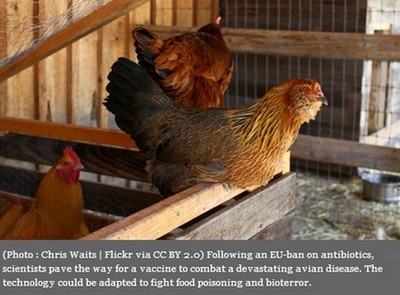Vaccine Strategy to Combat Necrotic Enteritis
Published: July 3, 2013
By: Medical Daily
Following an EU ban on livestock antibiotics, scientists pave the way for a vaccine to combat a devastating avian disease. The technology could be adapted to fight food poisoning and bioterror.
(The report was published in the Journal of Biological Chemistry and in Vaccine.)
(The report was published in the Journal of Biological Chemistry and in Vaccine.)
A vaccine candidate from the UK could save poultry farmers from a bacterial disease that is re-emerging across Europe and costs the global chicken industry $900 million annually.
The epidemic is due to a resurgence of the bacteria Clostridium perfringens, which causes a vicious intestinal disease in chickens known as necrotic enteritis. Related variants of the dangerous germ are also the 3rd leading cause of food poisoning in humans.
"Necrotic enteritis is a major concern for the poultry farming industry worldwide, and poultry producers are waiting for this desperately needed vaccine," said microbiologist Richard Titball of the University of Exeter, UK. "Our work will pave the way for the development of a vaccine that will help farmers tackle this devastating disease."
The symptoms are often mild in the beginning and difficult to detect. Later, chickens gradually waste away, while farmers unknowingly allow the disease to spread to other birds.
Europe has been hit especially hard by this blight in recent years because of an EU ban on the use of antibiotic growth promoters in farm chickens. Prior to 2006, these drugs were added to chickenfeed to promote their growth, leading to bigger chickens for market, but had the added benefit of protecting the fowl from C. perfringens.
But given the rise in antibiotic-resistant infections on domestic farms and the possible transmission of these diseases into humans, the EU disallowed antibiotics in feedstuffs.
Scientists at the University of Exeter have devised a solution that neutralizes the chicken-harming germ C. perfringens without setting up a scenario for drug resistance.
C. perfringens bacteria secrete a family of toxins — alpha-, beta-, epsilon-, and iota-toxin — that trigger intestinal damage in both chickens and humans. It was recently revealed that beta-toxin is responsible for necrotic enteritis in poultry.
Titball and his team used genetic tools to alter the structure of the beta-toxin. The resulting vaccine precursor wouldn't cause harm if given to chickens, but would help them build immunity to the toxin.
Of the 25-28 chickens given immunizations, only 11 percent developed necrotic enteritis after being infected with C. perfringens. In contrast, 48 percent of the chickens given a placebo vaccine developed the disease. The researchers believe this four-fold reduction could be boosted further, by modifying the formula more to provide complete protection from the infection.
The next step is to improve the delivery of the vaccine candidate. In this study, the remedy was delivered by 3 injections, which would be laborious and impossible in the field. The researchers are devising an oral drug or an approach for vaccinating eggs.
"More work is needed to develop a perfect field vaccine, but we're coming closer and closer to it.," said co-author Dr. Filip Van Immerseel, a microbiologist at Ghent University, Belgium.
"This is a tremendous step towards developing a necrotic enteritis vaccine that will control this disease in the future," said first author Sergio Fernandes da Costa from the University of Exeter. "We are working closely with the animal health industry to develop a product that can be efficiently given to entire poultry flocks in feed or water."
The strains of C. perfringens that afflict chickens usually don't afflict humans. However, the dangers posed by the bacteria in humans could be reason to develop a similar vaccine for people.
Toxins created by the human-targeting strains can cause severe stomach illness as well as life-threating gangrene in limbs. Bioterror experts worry that these toxins could be weaponized into a breathable aerosol or used to contaminate water supplies.
A human vaccine is needed to protect against this possible threat, and the development strategy used in this study could be adapted for this purpose.
"All of the diseases caused by Clostridium perfringens rely on the production of toxins, " said Titball, "In principle, this same approach could be used to devise vaccines against the other diseases caused by Clostridium perfringens.
Sources: Fernandes da Costa SP, Mot D, Bokori-Brown M, Savva CG, Basak AK, Van Immerseel F, Titball RW. Protection against avian necrotic enteritis after immunisation with NetB genetic or formaldehyde toxoids. Journal of Biological Chemistry. 2013
Fernandes da Costa SP, Mot D, Bokori-Brown M, Savva CG, Basak AK, Van Immerseel F, Titball RW. Protection against avian necrotic enteritis after immunisation with NetB genetic or formaldehyde toxoids. Vaccine. 2013.
Source
Medical DailyRelated topics:
Recommend
Comment
Share

Would you like to discuss another topic? Create a new post to engage with experts in the community.









